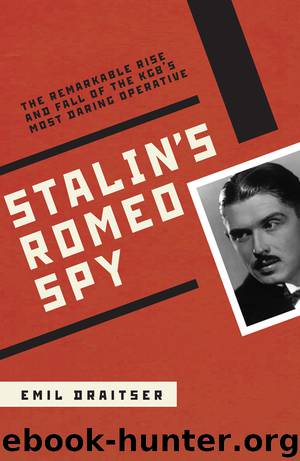Stalin's Romeo Spy by Emil Draitser

Author:Emil Draitser [Draitser, Emil]
Language: eng
Format: epub
ISBN: 9780715643150
Publisher: Gerald Duckworth & Co
Published: 2011-07-15T04:00:00+00:00
Bystrolyotov’s African Trip (1935–1936)
Of course, in his published work, duly censored by the KGB, there is no direct indication of the purpose of his second African trip. Moreover, to avoid disclosure of that clandestine intelligence operation and Bystrolyotov’s part in it, the journal editors resorted to a rather clumsy cover-up. They prefaced the publication of his notes with the statement that, although the author made the trip himself and the material is nonfictional (aimed, in the spirit of the time, to “expose the imperialist exploitation of the indigenous African people”), the story is written from the point of view of a fictional Dutch artist, “van Egmont,” who came to Africa in search of exotic subjects for his drawings (on the reasons for Dmitri’s choice of the name later).
In time, the journal notes and the drawings became part of Dmitri’s novel, V staroi Afrike (In Old Africa). In it, the author gives his fictional protagonist a more compelling reason to travel to the most remote and unexplored regions of Africa. He makes him a reporter for the European department of the International News and Photo Information Agency, “exploited by the bourgeois press thirsty for vulgar sensations.” (In his unpublished work, Bystrolyotov reveals that this was his true cover during the African mission.)7
There are numerous other indications in both the journal notes and the novel that the traveler is, in fact, Dmitri himself. In both texts, he gives his protagonist traits of his own personality and emotional makeup, as well as his most important biographical highlights: the “always absent” father, the demanding mother obsessed with social justice, a youth full of hardships and perilous experiences, including a near drowning in the sea. In addition, sloppy editorial work sporadically reveals glimpses of the writer’s personality, not his protagonist’s. For example, in one place the narration suddenly shifts from third person singular to first person plural. In another, the Dutch protagonist suggests calling a dog Polkan or Zhuchka, actually Russian names for a dog. In yet another, forgetting that he is a photo correspondent with no military background, the man warns one of his fellow travelers who behaves aggressively toward him: “I shoot without missing while standing, lying down, or hanging upside down. I never go anywhere without my weapon and open fire without aiming.”8
Thanks to all these and other editorial oversights, along with many keenly observed and minutely described scenes of overcoming the hard ships of crossing the difficult African terrain, both the travel notes and the novel read like Bystrolyotov’s African travelogue.
Of course, neither Soviet publication mentions the true reason for Bystrolyotov’s travel to the continent. But his unpublished work does. In both manuscripts, part of his memoirs titled “Tsepi i niti” (“Chains and Threads”) and his rejected screenplay “Generous Hearts,” he does spell out the purpose of his African trip (which may well be one of the reasons his screenplay was turned down).
Thus, from bits and pieces of information scattered throughout the pages of his published and unpublished work, the following picture emerges.
Download
This site does not store any files on its server. We only index and link to content provided by other sites. Please contact the content providers to delete copyright contents if any and email us, we'll remove relevant links or contents immediately.
| Arms Control | Diplomacy |
| Security | Trades & Tariffs |
| Treaties | African |
| Asian | Australian & Oceanian |
| Canadian | Caribbean & Latin American |
| European | Middle Eastern |
| Russian & Former Soviet Union |
The Secret History by Donna Tartt(18224)
The Social Justice Warrior Handbook by Lisa De Pasquale(11963)
Thirteen Reasons Why by Jay Asher(8472)
This Is How You Lose Her by Junot Diaz(6462)
Weapons of Math Destruction by Cathy O'Neil(5853)
Zero to One by Peter Thiel(5507)
Beartown by Fredrik Backman(5372)
The Myth of the Strong Leader by Archie Brown(5249)
The Fire Next Time by James Baldwin(5032)
How Democracies Die by Steven Levitsky & Daniel Ziblatt(4970)
Promise Me, Dad by Joe Biden(4916)
Stone's Rules by Roger Stone(4872)
100 Deadly Skills by Clint Emerson(4700)
A Higher Loyalty: Truth, Lies, and Leadership by James Comey(4565)
Rise and Kill First by Ronen Bergman(4553)
Secrecy World by Jake Bernstein(4406)
The David Icke Guide to the Global Conspiracy (and how to end it) by David Icke(4393)
The Farm by Tom Rob Smith(4332)
The Doomsday Machine by Daniel Ellsberg(4253)
